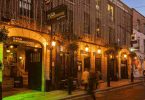Stark reading in Mintel’s Alcohol Retailing Report
Between 2009 and 2010 the value of the all-Ireland on-trade market fell by 14 per cent from €4 billion to €3.48 billion, but the off-trade saw its value increase by six per cent from €2.4 billion to €2.6 billion. In the years from 2005 to 2010 1,324 retailers closed in the Republic of Ireland and the Revenue Commissioners claim 914 licence holders did not renew between 2009 and 2010.
The cream on the cake? Further prices rises are imminent due to increasing raw materials costs. European grain prices hit a record €235 per tonne last August thanks to the Russian ban on grain exports following drought and fires. This affects beer most of all, which attracts 55 per cent of all sales in the on-trade. Then there’s the recent Chilean earthquake which affected wine production.
The good news is that innovation continues. In 2010, 247 new alcohol products were launched in UK and Irish markets. The key 18-24 market segment likes new products. Some of these new products were ‘ethical’ though arguably recession-hit customers may not be able to pay high prices for greener products. Increasingly, consumers tend to drink with a meal, which favours the many publicans who have expanded their food services – another positive.
The Report suggests how the Irish drink industry might adapt to keep itself profitable:
Respond to consumers’ desire for healthier lifestyles
A major push by alcohol manufacturers to reduce the alcohol content in some products might help maintain their customer base.
While consumers are becoming more health conscious, 83 per cent of RoI consumers have had a drink in the last 12 months and are likely to continue drinking if they feel that their drinks are less harmful to them.
Producing organic alcohol might help companies to justify premium prices.
In recent years, for example, the Beck’s beer brand has prominently marketed itself as containing no artificial additives, being made of four natural ingredients.
Pubs could offer low-alcohol beers at lower prices, enforce drinking limits on customers, or automatically give customers a glass of tap water with each drink to help them pace themselves.
Consider Green and ethical issues
Being demonstrably green may justify a premium price tag. Relevant information on the side of drinks cans or bottles – such as the percentage of packaging sourced from recyclable materials and any other green policies of the company such as using renewable energy sources – may promote sales.
Pubs and nightclubs could also appeal to green-minded consumers by eliminating the use of beer mats to reduce the level of paper they use, for example, or by using CFL lighting or installing renewable energy sources such as solar panels.
Use Local appeal
The Mintel Report Food and Drink Brand Dynamics – Ireland, August 2008 noted that consumers place more value in beer brands presented as being Irish, believing that locally-produced goods are worth paying more for. And the recession may have increased the willingness of Irish consumers to buy locally-produced brands.
Thus Alcohol manufacturers may benefit from using local ingredients where possible and highlighting this in promotions.
Use local events to boost alcohol consumption
In the Mintel report Heritage Tourism – Ireland, December 2010 it’s noted that Irish consumers are more likely to take a holiday at home. Thus Irish consumers need locally-held events for entertainment, providing the drinks industry with more opportunity to target the domestic tourism market.
Consider how legislation might affect the Irish alcohol market
Minimum pricing is to be implemented in the UK and could happen here. The Irish trade hopes this will stop below-cost selling in supermarkets and encourage a return to the pub. The VFI supports such a policy and believes it will save jobs in the industry.
Know what’s selling and who should be targeted
In the Republic beer is the most popular drink attracting 55 per cent of sales in the on-trade (value €1.6 billion) with the comparable figures for the off-trade 33 per cent and €599 million (see pie charts).
The over 60s are the dominant demographic in western society and their numbers are set to double by 2010 (UN figure). Due to the pension crisis many ‘seniors’ have to work longer but this endows them with spending power they wouldn’t have had before. These mature consumers have different expectations – a more relaxing environment accompanied by a more relaxed brand message. The Report therefore suggests marketing that might strengthen brand power via nostalgia. Over 33 per cent of ‘seniors’ believe it is worth paying more for quality wine.
Irish trade sources show a general increase in consumption by women and in particular in the 45-64 age groups in recent years. Alcohol manufacturers have been releasing new products targeted at women which are more likely to include fruity flavours and lower calorie content.
A Vinexpo survey (April 2009) of around 1,300 women aged between 18 and 60 in the UK found that women buy eight out of every 10 bottles of wine for home drinking with six in 10 women saying they drink wine at least once a week. It is likely that Irish women share similar buying patterns.
The 35-44 age group tends to go out about once a month. Targeting this age group and encouraging it to increase visits per month should be a priority for the pub industry. This is a challenge as consumers within this age group are more likely to have financial and family
responsibilities which limit their options.
Other target categories emerging from Mintel’s research are ‘light drinkers’, ‘socialites’ and ‘hangover haters’. These are described in the table here.
Consider Limited Editions to create ‘elite’ products
Limited editions enable companies to test and experiment with new drinks before launching them on the wider market. Consumers often find such products special and therefore worth paying more for.
Understand the competition – soft drinks, restaurants and the cinema
As health concerns increase soft drink sales, pubs need to ensure they stock a wide selection of soft drinks including the new ones on the market. Such a selection should be promoted to encourage non-drinkers and the designated driver. As pubs develop food services so they may benefit from the increasing numbers who like to drink with a meal. Cinema-going is very popular in Ireland but enterprising publicans could link in with local cinemas to provide a ticket/drink/meal offer.
Promoting alcohol as a gift
Branding alcoholic products as being the ideal gift to bring to a friend’s party or for an occasion might help boost sales in the off-trade.
React to TV and films
As noted in the Mintel Report White and Dark Spirits – Ireland, May 2009, TV programmes such as Sex and the City (as well as the films) have helped promote cocktails among women. Pubs and off-licences could adopt themes similar to these to reach out to female drinkers.
It’s suggested that the drinks industry could seek to commission programmes based on wine or life working in a vineyard to help boost the wine industry etc.
Shift brand positioning
In July 2009 Diageo, owner of the Smirnoff brand, changed the focus of the brand’s message from purity to its ‘Be there’ campaign centred around lifestyles and social activities, focussing on the drink as part of memorable and unique experiences. The campaign was supported by online marketing inviting people to share their stories.
This is an example of vodka brands being moved to coincide more with sociable drinking, similar to beer brands. Few drinkers enjoy drinking alone so when visiting pubs they are more inclined to opt for brands that they perceive as being more sociable.
With Irish consumers increasingly stressed by the recession, relaxation and ‘de-stressing’ could be powerful brand messages for alcohol products.
Summary
Irish consumers drink as many times per week as they ever have, but in terms of pure alcohol consumption, levels have fallen between 2001 and 2010.
A key challenge for the industry is to encourage drinkers to opt for premium-priced beverages to help maintain sales value. With consumers increasingly focused on health and the environment they may be willing to pay more for drinks that are positioned in this way.
For more information contact http://www.mintel.com








